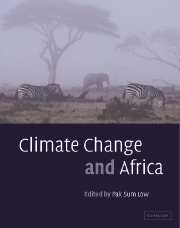Book contents
- Frontmatter
- Contents
- Notes on contributors
- Peer reviewers
- Editor's note
- Foreword
- Foreword
- Foreword
- Foreword
- Preface
- Preface
- Preface
- Preface
- List of abbreviations
- List of SI prefixes
- List of unit abbreviations
- List of chemical formulae
- Part I Science
- Part II Sustainable energy development, mitigation and policy
- 10 Biomass energy in sub-Saharan Africa
- 11 Natural resources: population growth and sustainable development in Africa
- 12 Sustainable energy development and the Clean Development Mechanism: African priorities
- 13 Opportunities for clean energy in the SADC under the UNFCCC: the case for the electricity and transport sectors
- 14 Regional approaches to global climate change policy in sub-Saharan Africa
- 15 Energy for development: solar home systems in Africa and global carbon emissions
- 16 Climate change in sub-Saharan Africa: assumptions, realities and future investments
- 17 Climate-friendly energy policies for Egypt's sustainable development
- Part III Vulnerability and adaptation
- Part IV Capacity-building
- Part V Lessons from the Montreal Protocol
- Index
13 - Opportunities for clean energy in the SADC under the UNFCCC: the case for the electricity and transport sectors
Published online by Cambridge University Press: 10 December 2009
- Frontmatter
- Contents
- Notes on contributors
- Peer reviewers
- Editor's note
- Foreword
- Foreword
- Foreword
- Foreword
- Preface
- Preface
- Preface
- Preface
- List of abbreviations
- List of SI prefixes
- List of unit abbreviations
- List of chemical formulae
- Part I Science
- Part II Sustainable energy development, mitigation and policy
- 10 Biomass energy in sub-Saharan Africa
- 11 Natural resources: population growth and sustainable development in Africa
- 12 Sustainable energy development and the Clean Development Mechanism: African priorities
- 13 Opportunities for clean energy in the SADC under the UNFCCC: the case for the electricity and transport sectors
- 14 Regional approaches to global climate change policy in sub-Saharan Africa
- 15 Energy for development: solar home systems in Africa and global carbon emissions
- 16 Climate change in sub-Saharan Africa: assumptions, realities and future investments
- 17 Climate-friendly energy policies for Egypt's sustainable development
- Part III Vulnerability and adaptation
- Part IV Capacity-building
- Part V Lessons from the Montreal Protocol
- Index
Summary
Keywords
Greenhouse gas emissions; electricity sector; transport; development; decarbonization; energy efficiency; clean energy and its financing; regional planning
Abstarct
This chapter presents opportunities for application of clean energy technologies in the power and transport sectors in the Southern African Development Community (SADC) region, which are the commercial energy sectors responsible for the largest share of greenhouse gas (GHG) emissions in the region. The region depends mainly on coal-based electricity and imported oil-dependent transport sectors, causing high GHG emissions and socio-economic impacts.
Most of the SADC countries have poor economies and, through power and transport development projects, have incurred debts which they cannot service. Hence, shifting to more benign energy technology solutions would not be easily realizable. Opportunities for funding clean energy projects under the United Nations Framework Convention on Climate Change (UNFCCC) should therefore be explored. Examples of clean energy solutions in the electricity and transport sectors that could be aligned with the UNFCCC requirements are presented, among them are decarbonization, energy efficiency and waste management technologies, and regional planning practices. Some clean energy options analysed for some countries in the region can be implemented at costs of less than US$10/tonne of carbon avoided and generally at negative costs, implying that it will be beneficial to the region to adopt these options, aside from their GHG reduction potential.
The relevant activities already being promoted under the SADC energy agenda are recognized and additional strategies are recommended.
- Type
- Chapter
- Information
- Climate Change and Africa , pp. 136 - 149Publisher: Cambridge University PressPrint publication year: 2005



